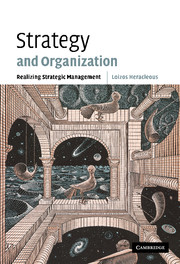Book contents
- Frontmatter
- Contents
- List of figures
- List of tables
- Preface
- I Bases of strategic management
- 1 The strategic management field
- 2 An organizational action view of strategic management
- 3 Strategic thinking or strategic planning?
- 4 Leadership research and the board of directors
- II Realizing strategy
- III Current themes and applications
- Index of names
- Index of subjects
- References
1 - The strategic management field
Published online by Cambridge University Press: 11 May 2010
- Frontmatter
- Contents
- List of figures
- List of tables
- Preface
- I Bases of strategic management
- 1 The strategic management field
- 2 An organizational action view of strategic management
- 3 Strategic thinking or strategic planning?
- 4 Leadership research and the board of directors
- II Realizing strategy
- III Current themes and applications
- Index of names
- Index of subjects
- References
Summary
Historical origins of the term “strategy”
Strategy as a term was coined in Athens around 508–7 bc, where ten strategoi comprised the Athenian war council and yielded both political and military power. Etymologically, strategos, or general, derives from stratos (the army) and agein (to lead). So, in this original sense, “strategy” is “the art of leading the army.” Concerns of early writers on strategy such as Aenias Tacticus, Pericles, and Xenophon included the qualities of effective strategoi, principles of employing the troops, and wider strategic goals such as Pericles' admonition about the “need to limit risk while holding fast to essential points and principles.” According to Xenophon, moreover, a commander “must be ingenious, energetic, careful, full of stamina and presence of mind, loving and tough, straightforward and crafty, alert and deceptive, ready to gamble everything and wishing to have everything, generous and greedy, trusting and suspicious.” An essential attribute of aspiring strategoi was “knowing the business which [they] propose to carry out.” A general was expected not only to plan for battle, but also to lead the troops into battle himself Cummings (1993).
Parallel developments in Asia included Sun Tzu's Art of War, dated to around the 5th century bc Sawyer (1996). Sun Tzu emphasized meticulous planning, the ideal of vanquishing the enemy indirectly without the need to fight, the qualities of effective generals, advice on managing the troops, and general principles and tactics of engaging with the enemy.
- Type
- Chapter
- Information
- Strategy and OrganizationRealizing Strategic Management, pp. 3 - 22Publisher: Cambridge University PressPrint publication year: 2003



